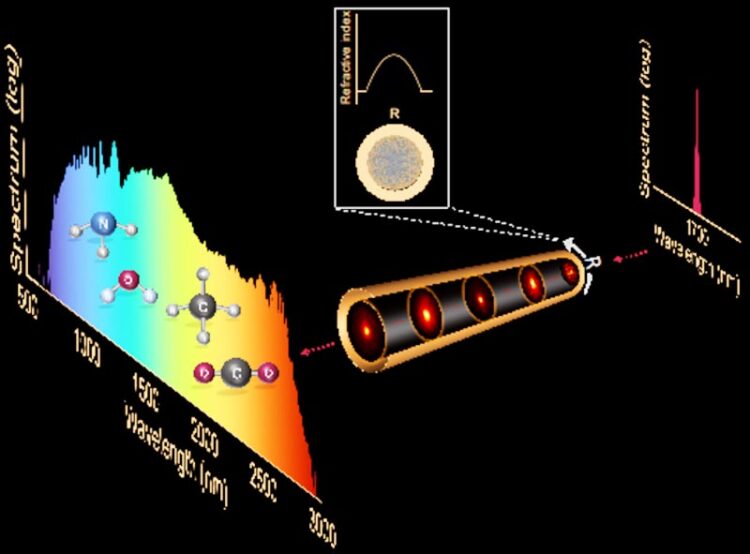New self-cleaning optical fiber

Utilizing two glasses with a different refractive index and stacked with a specific arrangement has allowed researchers to develop for the first time a multimodal fiber with a parabolic refractive index with transmission up to the mid-infrared and high nonlinearity. The spectrum of short pulses of light injected into the fiber massively broadens to span from the visible to mid-infrared. Significantly, unlike in conventional multimode fibers, the light beam remains smooth as the result of self-cleaning dynamics induced by the parabolic refractive index. Such a light source with ultrabroad spectrum, smooth beam and high power finds applications in e.g. environmental sensing or high-resolution imaging for medical diagnostics.
Credit: Tampere University
… can help in monitoring environment and diagnosing cancer.
When a high-power ultrashort pulse of light interacts with a material such as a glass optical fibre, a range of highly nonlinear interactions take place that cause complex changes in both the temporal and spectral properties of the injected light. When taken to the extreme, such interactions can lead to the generation of a rainbow laser of light commonly referred to as a supercontinuum light source. Since its first demonstration in a special type of optical fiber in 2000, supercontinuum laser light has revolutionized many areas of science, ranging from metrology and imaging at unprecedented resolution to ultrabroadband remote sensing and even the detection of exoplanets.
The current bottleneck with current supercontinuum sources, however, is that they are based on optical fibers that support a single transverse intensity profile or mode, which inherently limits their optical power. What’s more, conventional optical fibers are made of silica glass with transmission limited to the visible and near-infrared region of the spectrum. Extension of supercontinuum light to other wavelength regimes such the mid-infrared requires optical fibers made of so-called soft glasses, but these possess a lower damage threshold than silica, limiting even more the power of the supercontinuum beam.
Non-silica optical fiber with a self-cleaned beam
Recently, a different type of optical fiber with a refractive index that varies continuously across the fiber structure has been shown to yield a dramatic increase in supercontinuum power, while still preserving a smooth beam intensity profile. “The refractive index variation of such graded-index optical fibers leads to periodic focusing and defocusing of the light inside the fiber that enables coupling between spatial and temporal nonlinear light-matter interactions. This leads to a self-cleaning mechanism that yields supercontinuum light with high power and a clean beam profile. As well as their many applications, they also provide a means of studying fundamental physics effects such as wave turbulence”, says Professor Goëry Genty, the leader of the research group at Tampere University.
While these fibers have recently attracted significant attention from the research community, their use has been, up to now, restricted to the visible and near-infrared. In collaboration with the group of Profs. Buczynski and Klimczak at the University of Warsaw (Poland) and the group of Prof. Dudley in the University of Burgundy France-Comté (France), the Tampere team demonstrated for the first time the generation of a two-octave supercontinuum from the visible to mid-infrared in a non-silica graded-index fiber with a self-cleaned beam.
“This problem has now been solved by using a particular design that utilizes two types of lead-bismuth-gallate glass rods with different refractive indices drawn to yield a nanostructured core. The result is a graded-index fiber with an effective parabolic refractive index profile with transmission up to the mid-infrared, and, as cherry on the cake, enhanced nonlinear light-matter interactions,” says researcher Zahra Eslami.
Great potential in diagnostics and monitoring
The mid-infrared is of crucial interest as it contains the characteristic vibrational transitions of many important molecules.
“The novel solution will lead to more efficient supercontinuum light sources in the mid-infrared with many potential applications e.g., for pollutant tagging, cancer diagnostics, machine vision, environmental monitoring, quality and food control,” explains Genty.
The researchers anticipate that this novel type of fiber will very soon become an important and standard material for the generation of broadband sources and frequency combs.
The research was carried out at Tampere University and within the Academy of Finland Flagship for Photonics Research and Innovation (PREIN).
Read more on Two octave supercontinuum generation in a non-silica graded-index multimode fiber, Nature Communications 13, 2126 (2022) (https://doi.org/10.1038/s41467-022-29776-6). The article was written by Zahra Eslami, Lauri Salmela, Adam Filipkowski, Dariusz Pysz, Mariusz Klimczak, Ryszard Buczynski, John M. Dudley, and Goëry Genty.
Journal: Nature Communications
DOI: 10.1038/s41467-022-29776-6
Subject of Research: Not applicable
Article Title: Two octave supercontinuum generation in a non-silica graded-index multimode fiber
Article Publication Date: 19-Apr-2022
All latest news from the category: Physics and Astronomy
This area deals with the fundamental laws and building blocks of nature and how they interact, the properties and the behavior of matter, and research into space and time and their structures.
innovations-report provides in-depth reports and articles on subjects such as astrophysics, laser technologies, nuclear, quantum, particle and solid-state physics, nanotechnologies, planetary research and findings (Mars, Venus) and developments related to the Hubble Telescope.
Newest articles

Superradiant atoms could push the boundaries of how precisely time can be measured
Superradiant atoms can help us measure time more precisely than ever. In a new study, researchers from the University of Copenhagen present a new method for measuring the time interval,…

Ion thermoelectric conversion devices for near room temperature
The electrode sheet of the thermoelectric device consists of ionic hydrogel, which is sandwiched between the electrodes to form, and the Prussian blue on the electrode undergoes a redox reaction…

Zap Energy achieves 37-million-degree temperatures in a compact device
New publication reports record electron temperatures for a small-scale, sheared-flow-stabilized Z-pinch fusion device. In the nine decades since humans first produced fusion reactions, only a few fusion technologies have demonstrated…





















